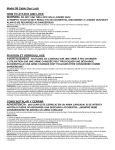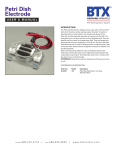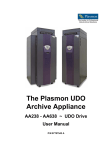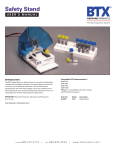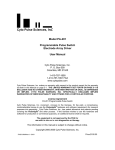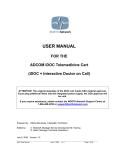Download User`s Manual
Transcript
User’s Manual ECM® 399 Electroporation System 45-0050 45-0050INT ECM® 399 Electroporator only (110V) ECM® 399 Electroporator only (220V) Publication 5501-004-REV-E WEEE/RoHS Compliance Statement EU Directives WEEE and RoHS To Our Valued Customers: We are committed to being a good corporate citizen. As part of that commitment, we strive to maintain an environmentally conscious manufacturing operation. The European Union (EU) has enacted two Directives, the first on product recycling (Waste Electrical and Electronic Equipment, WEEE) and the second limiting the use of certain substances (Restriction on the use of Hazardous Substances, RoHS). Over time, these Directives will be implemented in the national laws of each EU Member State. Once the final national regulations have been put into place, recycling will be offered for our products which are within the scope of the WEEE Directive. Products falling under the scope of the WEEE Directive available for sale after August 13, 2005 will be identified with a “wheelie bin” symbol. Two Categories of products covered by the WEEE Directive are currently exempt from the RoHS Directive – Category 8, medical devices (with the exception of implanted or infected products) and Category 9, monitoring and control instruments. Most of our products fall into either Category 8 or 9 and are currently exempt from the RoHS Directive. We will continue to monitor the application of the RoHS Directive to its products and will comply with any changes as they apply. • Do Not Dispose Product with Municipal Waste • Special Collection/Disposal Required ECM ® 399 Electroporation System Table of Contents General Information: Serial Number ................................................................2 Calibration ......................................................................2 Warranty ....................................................................2-3 Service ........................................................................3-4 Repair Facilities and Parts ..............................................4 General Safety Summary..............................................5-6 Electrical & Technical Specifications ..............................7 General Specifications......................................................8 Introduction: ECM® 399 Features ........................................................9 Operation: Getting Started ............................................10 Quick Start: Connecting ..................................................................11 Initializing......................................................................11 Instrument Controls................................................11-13 Operating Basics ............................................................14 Electroporation ..............................................................15 Applications: Electroporation........................................................16-17 Appendix A: Optimization Strategies............................18 Appendix B: Pulse Length Targeting ......................19-20 Appendix C: Electrical Troubleshooting ........................21 Appendix D: Experimental Troubleshooting ................22 Appendix E: Glossary of Electrical Terms ..............23-24 Appendix F: Glossary of Biological & Technical Terms ..................................25-26 Appendix G: Recommended Reading............................27 Appendix H: Accessories and Replacement Parts ......28 Appendix I: General Care and Cleaning ......................28 Page 1 www.btxonline.com ECM ® 399 Electroporation System General Information Serial Number The serial number for the ECM® 399 is located on the rear of the instrument case. All inquiries concerning these products should refer to the serial numbers on the units. Calibration There is no calibration required for the ECM® 399. Warranty BTX - Harvard Apparatus warranties the ECM® 399 for a period of two years from the date of purchase. At its option, BTX – Harvard Apparatus will repair or replace the unit if it is found to be defective as to workmanship or materials. This warranty does not extend to any instrumentation which has been (a) subjected to misuse, neglect, accident or abuse, (b) repaired or altered by anyone other than BTX - HARVARD APPARATUS without BTX - HARVARD APPARATUS’ express and prior approval, (c) used in violation of instructions furnished by BTX - HARVARD APPARATUS. This warranty extends only to the original customer purchaser. Failure to use the Enhancer 3000 High Voltage probe to connect a BTX Generator to an external digital oscilloscope for monitoring will result in voiding your warranty; connecting directly to the external monitoring equipment or modified monitoring setup will damage the Generator. IN NO EVENT SHALL BTX - HARVARD APPARATUS BE LIABLE FOR INCIDENTAL OR CONSEQUENTIAL DAMAGES. Some states do not allow exclusion or limitation of incidental or consequential damages so the above limitation or exclusion may not apply to you. THERE ARE NO IMPLIED WARRANTIES OF MERCHANTABILITY, OR FITNESS FOR A PARTICULAR USE, OR OF ANY OTHER NATURE. Some states do not allow this limitation on an implied warranty, so the above limitation may not apply to you. Without limiting the generality of the foregoing, BTX - HARVARD APPARATUS shall not be liable for any claims of any kind whatsoever, as to the equipment delivered or for non-delivery of equipment, and whether or not based on negligence. Warranty is void if the ECM® 399 is changed in any way from its original factory design or if repairs are attempted without written authorization by BTX - HARVARD APPARATUS. Warranty is void if parts, connections or cell fusion chambers not manufactured by BTX - HARVARD APPARATUS are used with the ECM® 399. Warranty is void if the Enhancer 3000 High Voltage probe is not used when connecting BTX Generators to external monitoring digital scope; as connecting directly to the external monitoring equipment will damage the Generator. Page 2 www.btxonline.com ECM ® 399 Electroporation System General Information (Continued) If a defect arises within the warranty period, promptly contact BTX – Harvard Apparatus, 84 October Hill Road, Building 7, Holliston, Massachusetts, USA 01746-1388 using our toll free number 1-800-272-2775 (US Only) or 508-893-8999 (E-mail: techsupport.btx@harvardapparatus.com). Goods will not be accepted for return unless an RMA (Returned Materials Authorization) number has been issued by our customer service department. The customer is responsible for shipping charges. Please allow a reasonable period of time for completion of repairs, replacement and return. If the unit is replaced, the replacement unit is covered only for the remainder of the original warranty period dating from the purchase of the original device. This warranty gives you specific rights, and you may also have other rights, which vary from state to state. Service All service under the warranty will be made at the BTX - HARVARD APPARATUS, Holliston, Massachusetts facilities or an authorized service site. Owner will ship instrument prepaid to Holliston, Massachusetts, USA or the service site. BTX - HARVARD APPARATUS will return the instrument after servicing, freight prepaid to owner’s address. Obtaining Service: Service During Warranty 1. Write or call the BTX - HARVARD APPARATUS Customer Support Group and describe the nature of the problem. 2. Carry out minor adjustments or tests as suggested by BTX - HARVARD APPARATUS. 3. If proper performance is not obtained, BTX - HARVARD APPARATUS will notify you to ship the instrument, prepaid, to its Service Department.The instrument will be repaired and returned at no charge for all customers in the continental United States. Customers outside of the continental United States who have purchased our equipment from distributors should contact the distributor. If you have purchased your equipment from us, you should contact us directly. We will repair at no charge, but will not pay for shipment, documentation, etc. These charges will be billed at cost. Note: Under no condition should the instrument or accessories be returned without prior approval from BTX - HARVARD APPARATUS. An RMA (Returned Materials Authorization) number must be obtained. Page 3 www.btxonline.com ECM ® 399 Electroporation System General Information (continued) Out-Of-Warranty Service Proceed exactly as for Warranty Service, above. If our Service Department can assist you by phone or correspondence, we will be glad to, at no charge. Repair service will be billed on the basis of labor and materials. A complete statement of time spent and materials used will be supplied. Shipment to BTX - HARVARD APPARATUS should be prepaid. Your bill will include return shipment freight charges. Disassembly by the user is prohibited. Service should only be carried out by experienced BTX - HARVARD APPARATUS technicians. Repair Facilities and Parts BTX - Harvard Apparatus stocks replacement and repair parts. When ordering, please describe parts as completely as possible, preferably using our part numbers. If practical, enclose a sample or drawing. We offer complete reconditioning service. Page 4 www.btxonline.com ECM ® 399 Electroporation System General Safety Summary Review the following safety precautions to avoid injury and prevent damage to this product or any products connected to it. To avoid potential hazards, use this product only as specified. Only qualified personnel should perform service procedures. To Avoid Fire or Personal Injury USE PROPER POWER CORD Use only the power cord specified for this product and certified for the country of use. CONNECT AND DISCONNECT PROPERLY Do not connect or disconnect probes or test leads while they are connected to a power source. GROUND THE PRODUCT This product is grounded through the grounding conductor of the power cord. To avoid electric shock, the grounding conductor must be connected to earth ground. Before making connections to the output terminals of the product, ensure that the product is properly grounded. OBSERVE ALL TERMINAL RATINGS To avoid fire or shock hazard, observe all ratings and markings on the product. Consult the product manual for further ratings information before making connections to the product. DO NOT OPERATE WITHOUT COVERS Do not operate this product with covers or panels removed. Use Proper Fuse. Use only the fuse type and rating specified for this product. AVOID EXPOSURE TO CIRCUITRY Do not touch exposed connections and components when power is present. DO NOT OPERATE IN LOW IMPEDANCE Sample: Load or Sample If the electroporation samples have impedance of less than 20 Ω in LV and 40 Ω in HV, the samples may arc and result in sample loss and potential damage to unit. DO NOT OPERATE WITH SUSPECTED FAILURES If you suspect there is damage to this product, have it inspected by qualified service personnel. PROVIDE PROPER VENTILATION Refer to installation instructions for details on installing the product to ensure proper ventilation. DO NOT OPERATE IN WET/DAMP CONDITIONS Page 5 www.btxonline.com ECM ® 399 Electroporation System General Safety Summary (Continued) DO NOT OPERATE IN AN EXPLOSIVE ATMOSPHERE KEEP PRODUCT SURFACES CLEAN AND DRY Should you have any safety concerns, immediately contact BTX Technical Support (1-800-597-0580) Safety Terms and Symbols: Terms that appear in this manual: WARNING. Warning statements identify conditions or practices that could result in injury or loss of life. CAUTION. Caution statements identify conditions or practices that could result in damage to these products or other property. Symbols that may appear on the products: Page 6 Danger Attention Protective Functional High Voltage Refer to Manual (Earth) Terminal Ground www.btxonline.com ECM ® 399 Electroporation System Electrical & Technical Specifications Standard Capabilities: Display Power Source Voltage Power Fusing Type: 16-character liquid crystal LCD backlit 100 to 240 Vac, 50 to 60 Hz, CAT I < 100 W peak 2.5 A, T rating 250 V Environmental Characteristics: Intended Use Indoor use only Operating Temperature 10ºC to 40ºC Cooling Convection through metal case Relative Humidity 60% Altitude 2,000 m (operating) Mechanical Characteristics: Maximum Voltage Output: 2,500 Volts Peak Maximum Pulse Length 125 ms @ 500 Volts peak or 5 ms @ 2,500 Volts peak Pollution Degree 2 (Not to be operated in conductive pollutants atmosphere) Page 7 www.btxonline.com ECM ® 399 Electroporation System General Specifications General Specifications, Certifications & Compliances EMC Overvoltage Category: CAT III: Products in this Category: Distribution-level mains, fixed installation. CAT II: Local-level mains, applications, portable equipment. CAT I: Signal levels in special equipment or parts of equipment, telecommunications, electronics. EMC Meets requirements of Directive 89/336/EEC for Electromagnetic Compatibility (EC) and Low-Voltage Directive 73/23/EEC for Product Safety. Compliance was demonstrated to the following specifications as listed in the Official Journal of the European Communities: EN 50081-1 Emissions EN 55011 Class B Radiated and Conducted Emissions EN 55082-1 Immunity IEC 10004-2 Electrostatic Discharge Immunity IEC 10004-3 RF Electromagnetic Field Immunity IEC 10004-4 Electrical Fast Transient/Burst Immunity Safety Low Voltage Directive 73/23/EEC EN 61010-1 Safety requirements for electrical equipment for measurement, control and laboratory use. BTX INSTRUMENTS ARE DESIGNED FOR IN VITRO AND IN VIVO ANIMAL AND PLANT APPLICATIONS ONLY, AND ARE NOT FOR HUMAN USE Page 8 www.btxonline.com ECM ® 399 Electroporation System Introduction The ECM® 399 is an electroporation system specifically designed to produce the precise field strengths and pulse lengths required for the transformation of gram -bacteria yeast and limited transfection of mammalian cells. ECM® 399 features include: • Sophisticated digital design • High resolution, easy to read Liquid Crystal Display providing readout of: status, voltage mode, setpoint and actual parameters • Voltage range of 2 to 500 V with 2V resolution in LV mode with a 150 ohm resistance and 1050 µF capacitance delivering a pulse length of approximately 5 to 55 msec using a low impedance electroporation buffer depending on volume and temperature • Voltage range of 10 to 2500 V with 10 V resolution in HV mode with a 150 ohm resistor and a 36 µF capacitor delivering a pulse length of approximately 5 msec using a high impedance electroporation buffer • Easy three step experimental approach: simply initialize instrument, dial in voltage and mode with the voltage adjust knob, and deliver electroporation pulse by pressing the start switch • Dual monitoring and display of peak output voltage and time constant to ±1 percent Page 9 www.btxonline.com ECM ® 399 Electroporation System Operation: Getting Started Carefully open the box containing the ECM® 399 Electroporation System. Verify receipt of the following items: ECM® 399 Pulse Generator (1) Power Cord (1) BTX Electroporation Systems may be customized with the addition of various electrodes and accessories. The following items complete a typical system order: Personal Electroporation Pack (1) Model 610 BTX Cuvettes Plus (10) Model 620 BTX Cuvettes Plus (10) Fig 1 - Typical ECM® 399 System Components Model 640 BTX Cuvettes Plus (10) If you have ordered alternative or different items, please verify their receipt. Page 10 www.btxonline.com ECM ® 399 Electroporation System Quick Start Installing 1. Install on Bench or work table 2. Allow 1 to 2 inches of clearance for proper cooling. It is normal for the instrument to be slightly warmer than its operating environment. 3. Choose and outlet that is readily accessible. Connecting 1. Insert female end of power cord into male power interface on the back panel of the ECM® 399. 2. Plug male end of power cord into appropriate electrical outlet. 3. Insert male banana plugs of the Personal Electroporation Pack (PEP™) into HV output located on front panel of the ECM® 399. Initializing 1. Push the power switch located on the front panel of the ECM® 399. 2. The ECM® 399 will go through a series of self-test algorithms to test generator functionality. 3. The display will flash “BTX ECM® 399 V1.04” prior to attaining a ready status. 4. The first time the instrument is initialized, the display will then read “2500V HV” Voltage Adjust Knob Instrument Controls Power Switch Display 1. Switch located on the lower right front panel. 2. Press once to initialize the ECM® 399 and once more to turn off. High Voltage Output Page 11 Start Switch Power www.btxonline.com ECM ® 399 Electroporation System Quick Start (Continued) Display The ECM® 399 display will show operational status, voltage mode, and set voltage before delivery of an electroporation pulse. The display will read the peak output voltage delivered and the time constant following the delivery of a pulse. Status Ready Operational and ready to set voltage or deliver a pulse. Charging Charging capacitor to the preset voltage level. Pulsing Delivering a voltage pulse. Feedback Displays peak voltage and time constant. Sequence Aborted Aborted delivery of a pulse at the user’s request. SCR Failure Has not detected an output pulse during the pulsing operation. A short in the electrode could be the cause. This condition can only be reset by turning the power off. Charge Failure Failure to charge capacitors properly. Pressing the start switch resets this message. Setpoint too Low User has entered setpoint outside of normal operating specifications. Mode The ECM® 399 will display HV for the high voltage mode and LV for low voltage mode. Set Voltage The ECM® 399 will display set voltage in 2 volt increments in LV mode, from 2 to 500 V and in 10 volt increments in HV mode from 10 to 2500 V. Page 12 www.btxonline.com ECM ® 399 Electroporation System Quick Start (Continued) Actual Parameter Display The ECM® 399 will display the peak discharge voltage (Vp) in V and the time constant (t) in msec. It is normal for the measured voltage to be slightly different than the setpoint. The voltage difference is due to internal resistance and fluctuates with electrical load variations (buffer resistivity). Voltage Adjust Knob The ECM® 399 Voltage Adjust Knob adjusts the voltage from 2 to 500 V in the LV mode in 2 volt increments and from 10 to 2500 V in the HV mode in 10 volt increments. In the LV mode, increasing of the voltage setpoint past 500 V will result in a switch to the HV mode. The generator will emit a “beep” signaling a change from the LV mode to the HV mode. The voltage will then readjust to 0 volts, then continue up to 2500 V. In the HV mode, decreasing the voltage setpoint past 0 volts will result in an automatic switch to the LV mode, accompanied by a “beep”. The voltage will then readjust to 500 V. Following the delivery of a pulse, rotate the Voltage Adjust Knob to return to the ready mode. If the voltage adjust knob is set between detentes (notches), the generator may cycle through the actual parameter display following the delivery of a pulse, as if the knob were rotated as above. The voltage adjust knob is speed sensitive. A quick rotation of the knob increases the rate of change of any setpoint. Note: There are no other steps necessary to change the voltage mode other than adjustment of the Voltage Adjust Knob. Start Switch The green Start Switch is activated in the “ready” mode to deliver the electroporation pulse. Once the start switch is activated, the generator will “settle” by bleeding off the capacitors to the preset voltage, prior to delivering the pulse. The maximum settling time is 6 seconds. A pulse sequence may be aborted by pressing the start switch a second time, before delivery of the pulse. Following the delivery of a pulse, press the start switch once to return to the “ready” mode. • Actual voltage delivered under load will be lower than the set voltage, typically by 1 to 15 % • Voltage adjust knob controls set voltage AND voltage mode. There is NO separate voltage mode switch! Page 13 www.btxonline.com ECM ® 399 Electroporation System Operating Basics Use with the Personal Electroporation Pack (PEP) 1. Insert the PEP banana plugs into the HV output on the front panel of the ECM® 399. 2. Press the power switch to initialize the ECM® 399. 3. Verify that the ECM® 399 is in the “ready” mode. 4. Dial in the appropriate voltage and mode (LV or HV) with the Voltage Adjust Knob. PEP 45-0212 5. Verify that the ECM® 399 is in the proper voltage (HV or LV) mode. 6. Prepare sample, pipette into the appropriate BTX Disposable Cuvettes Plus, place the cuvette in the PEP and secure with the PEP safety “swing” shield. 7. Press the Start Switch. The ECM® 399 will charge and then deliver the electroporation pulse. A beep will indicate that the pulse has been delivered. 8. Process sample. Do not forget to record peak voltage and time constant for documentation purposes. 9. To return to “ready” mode, either rotate the Voltage Adjust Knob or press the Start Switch. 630B 45-0207 10. To abort a pulse before delivery, press the Start Switch during the “charging” mode. Use with Alternative Safety Stands 630B 1. Insert the safety stand banana plugs into the HV output on the front panel of the ECM® 399. 2. Follow steps 2 to 5 above. 3. Follow the Safety Stand instructions for insertion of the cuvette into the safety stand. 4. Page 14 Follow steps 7 to 10 above. www.btxonline.com ECM ® 399 Electroporation System Electroporation Electroporation is the application of controlled, pulsed electric fields to biological systems. If the biological system contains a lipid bilayer, such as is the case if the system is a suspension of cells or liposomes, the pulsed electric field may overcome the field potential of the lipid bilayer, resulting in a reversible breakdown of the bilayer and a resulting formation of temporal pores in the membrane. The pores formed are of the order of 40 to 120 nm. Most pores reseal within a few seconds, after allowing the transfer of materials into and out of the cells. During a typical electroporation process, target cells and molecules are mixed together. When an electroporation pulse is delivered, the result is the formation of temporal pores. Before the pores reseal, the target molecules are observed to enter the cells. Upon resealing of the pores, the molecules become incorporated within the cell. The eventual target site depends on the application; for example, molecules can remain in the cytoplasm, interact with the membrane, and move into the nucleus. Pore Formation Electroporation Process Applications for electroporation include permeabilization of virtually all cells to a wide variety of molecules and ions. The most common applications for electroporation are the transformation or transfection of cells with DNA or RNA. Other applications for electroporation include electroactivation, electroinsertion of proteins into cell membranes and electroextraction of molecules from cells. Although electroporation has mainly been used as a research tool, recent work has demonstrated its potential for clinical applications. Some areas being explored include: • electrochemotherapy which involves electroporation for delivering chemotherapeutic agents directly to tumor cells • encapsulation of drugs/genes into cells for their use as carrier systems • transdermal delivery of drugs/genes • gene therapy and delivery of drugs/genes with an electroporation catheter. Electroporation can be characterized by waveform. BTX exponential decay waveform generators, such as the BTX ECM® 399 and ECM® 630 deliver an exponentially decaying pulse. The length of such a discharge waveform is commonly characterized by the time required for the initial voltage to decay to 1/e (roughly 1/3) of the initial value. To achieve a desired pulse length, appropriate resistance and capacitance must be selected on the instrument. Voltage may be directly set on the instrument. Page 15 Exponential Decay Wave www.btxonline.com ECM ® 399 Electroporation System Applications Electroporation Bacteria and Yeast Electroporation The most common application is transformation. Field strength and pulse length are critical parameters for reporting, optimization, and troubleshooting bacterial and yeast applications. Mammalian Cell Electroporation Electroporation has been used successfully to introduce many different molecule types into cells. Most commonly, electroporation is used for the process of transfection, in which nucleic acid (DNA and RNA), is introduced into cells. Electroporation can be used to deliver oligonucleotides into cells for anti-sense applications. It can be used to deliver proteins into cells, even large enzymes such as restriction enzymes, and antibodies, for various purposes. Peptides have also been electroincorporated. Smaller molecules have been incorporated into cells and liposomes, such as dyes, sugars, and dNTP’S. High GFP expression in Mouse PE501 Electroporation has been used to study cellular activation processes, by electropermeabilizing cells to Ca2+, Mg2+, and Na+. Electroporation is also used to electroinsert proteins into the cell membrane. Finally, electroporation has been used to introduce drugs, such as the chemotherapeutic agent bleomycin, into cancer cells, in vitro and in vivo. The use of low impedance buffers such as PBS may result in a voltage drop so that the actual peak voltage delivered to samples may be less than the set voltage. With exponential decay generators, monitoring is necessary to identify the pulse length, or time constant, since this parameter may be very much dependent on the impedance of the sample (sample load). When using complex and custom electroporation applicators and chambers, the electroporation waveform may be altered and monitoring is again strongly recommended. Molecules Introduced by Electroporation • • • • • • • • • • • • • Page 16 DNA RNA siRNA miRNA dNTPS Enzymes Antibodies Other Proteins Peptides Dyes Sugars Ions Other Molecules www.btxonline.com ECM ® 399 Electroporation System Applications (Continued) Plant Protoplast Electroporation Electroporation has been used to introduce molecules into plant protoplasts, pollen, and most recently, direct transfer into plant tissue (in vivo). Page 17 www.btxonline.com ECM ® 399 Electroporation System Appendix A: Optimization Strategies General The success of electro cell manipulation (ECM) lies in selecting appropriate ECM systems capable of delivering the pulses suitable for the cell being electromanipulated. One, or several pulses of the appropriate field strength, pulse length, and wave shape may be required for this purpose. (Depending on the generator selected.) The key to success with electroporation-based technologies involves a proper combination of biological, physical, chemical, and pulse parameters. In general, cells must be in mid-logarithmic growth for optimal electroporation. Various temperature regimens have been described. It has been shown that a variety of chemical techniques may increase electroporation efficiencies, including addition of EDTA, DMSO, intracellular salts, and serum before or after the pulse. Optimizing protocols abound. Analysis of these optimization regimens has lead to proposals of universal protocols, involving very limited optimization over a narrow range. Electroporation 1. Vary the voltage in order to vary the field strength kv/cm, keeping other parameters constant. Assay sample for both viability and endpoint. Plot the field strength versus both viability and endpoint and extrapolate the optimal field strength (voltage divided by gap size) and voltage. 2. Vary the capacitance/resistance/sample volume in order to vary the pulse length (time constant) for exponential decay instruments. Directly vary square wave instrument pulse length. Assay sample for both viability and endpoint. Plot the pulse length versus both viability and endpoint and extrapolate the optimal pulse length/parameters. 3. For multiple pulsing systems/protocols, vary the number of pulses at the optimal field strength kv/cm and pulse length. Assay sample for both viability and endpoint. Plot the number of pulses versus both viability and endpoint, and extrapolate the optimal number of pulses. Page 18 www.btxonline.com ECM ® 399 Electroporation System Appendix B: Pulse Length Targeting Choosing A Volume To Obtain A Predetermined Pulse Length For The ECM® 399 or ECM® 395 Purpose Derive pulse length curves for the ECM® 399 so the user can choose a volume in order to meet a particular pulse length requirement. This Application Note is useful when the researcher wants to reproduce a protocol with a specific pulse length. The 2-step process illustrated below allows the researcher to choose a volume which will provide the desired pulse length. Definition of Terms Rs = Sample or chamber resistance. R SYS = Internal resistance of the ECM® 399 or 395. CSYS = Internal capacitance of the ECM® 399 or 395. T = Time constant or pulse length delivered to sample. Tools or Parts Needed Any electrode, any media, ECM® 399 or 395, and an optional Enhancer 3000®. Comments This Application Note is provided so the user can create his/her own plots. Application 1. Find the resistance of the sample. A quick and easy way to do this is by pulsing the sample once and measuring the pulse length. The resistance of the sample can be calculated with the following equation: Rs = Page 19 R T SYS* (R C )-T SYS* SYS www.btxonline.com ECM ® 399 Electroporation System Appendix B: Pulse Length Targeting (Continued) The pulse length may be measured by either the feedback from the ECM® 399 or by using the Enhancer® 3000. If this is done for different volumes, a sample resistance curve can be constructed. 2. Choose an adequate volume and use the corresponding sample resistance to find the pulse length in milliseconds by the equation below. T= Rs * Rsys Rs + Rsys * Csys * 10 -3 Using different sample resistances a plot of pulse length for each volume can be made. Page 20 www.btxonline.com ECM ® 399 Electroporation System Appendix C: Electrical Troubleshooting Instrument does not power up: Verify that the power cord is fully inserted in the instrument and in the wall outlet. Verify that the fuse is not blown. Disconnect power cord from the instrument before removing the fuse holder. Replace the fuse, if necessary, with same rated fuse as indicated on back panel. The ECM® 399 is constantly monitoring the parameters of some of its internal circuitry. In the case of a malfunction, one of the following messages will appear on the display. Note the instructions on the following page. SCR Failure: The ECM® 399 has not detected an output pulse during the pulsing operation. A short in the electrode could be the cause. Unplug the generator for 90 seconds then reset by cycling the power and pulsing one more time. If the same message reappears, call BTX Customer Service. Charge Failure: The ECM® 399 has detected a failure to charge its capacitors properly. Press the start switch to reset this message. A very low line voltage or a brownout is likely the cause. Verify that the circuit powering the ECM® 399 is adequately rated. If the message persists, call BTX Customer Service. Setpoint too Low: The user has entered a setpoint that is outside of normal operating specifications. Increase voltage setting. Page 21 www.btxonline.com ECM ® 399 Electroporation System Appendix D: Experimental Troubleshooting Arcing Verify electrical component functionality. Verify properties of cell sample (do cells need to be washed? Is the buffer appropriate for application?). Verify properties of transfectant/molecule (Is the DNA well purified?) Try reducing the voltage or increase sample volume until arcing is no longer a problem. Low (or no) transfection efficiency, or incorporation Verify physical, biological, and chemical parameters. Verify delivery of the pulse and pulse parameters. Is the voltage correct? Chamber gap? Pulse length or appropriate instrument settings? Number of pulses? If so, follow Optimization Guidelines outlined in Appendix A. Low viability Verify physical, biological, and chemical parameters. Are the voltage, chamber gap, pulse length (time constant), pulse number and other instrument settings correct? If so, reduce voltage, pulse length, or number of pulses and re-optimize protocol to improve viability as outlined in Appendix A. Page 22 www.btxonline.com ECM ® 399 Electroporation System Appendix E: Glossary of Electrical Terms Amplitude The instantaneous value of current or voltage in amperes or volts. Capacitor A device that stores electric energy in the form of an internal electric field. Energy is delivered when a current flows out of a capacitor. The current normally follows an exponential curve. Dielectric A material that has a high resistivity and can store energy in the form of an electric field. Direct Current (DC) Current whose amplitude is constant with time. Direct currents are used to form temporary pores in bi-lipid membranes. Cells may fuse when pores in the membranes of two juxtaposed cells reseal after a DC application. Divergence The deviation of electric field lines from a parallel homogeneous condition. A highly divergent field has field lines that rapidly change amplitude (or strength) and direction in the area of interest. Electric Field The electric potential difference between two points divided by the distance separating those points. Expressed in volt/cm. Electric Field Force The mechanical force acting on any electric charge when placed in an electric field. Exponential Decay Non linear waveform typical of capacitor charge and discharge currents and voltages. The exponential decay waveform is characterized by its time constant, the time it takes the voltage to decay to 1/e of the peak voltage. -----1/e Field Strength See Electric Field. Frequency The number of times an oscillation goes through a complete cycle in one second. The unit is either cycle/sec or Hertz (Hz). Homogenous Electric Field An electric field where the direction and strength of the field lines are constant. Page 23 www.btxonline.com ECM ® 399 Electroporation System Appendix E: Glossary of Electrical Terms (Continued) Heterogeneous Electric Field An electric field where the direction and strength of the field lines is varying. Potential The difference in volts between two points in space. Pulse Length The length of time that an electric signal is present. The end of an exponential pulse is the point at which the waveform has decayed to 1/e of the peak value. Voltage The difference of electric potential between two points in space. Expressed in volts (V). Wave Forms The shape of time varying electric signals. Typically exponential decay, square. Page 24 -T1/e www.btxonline.com ECM ® 399 Electroporation System Appendix F: Glossary of Biological & Technical Terms Dielectric Breakdown The reversible breakdown of lipid bilayer membranes as a result of the application of a DC electroporation pulse. Sufficiently high field strength may increase the membrane potential past a critical point leading to the breakdown of the membrane. Electroinsertion The use of electroporation to insert molecules into lipid bilayer membranes. Electropermeabilization The use of electroporation to make cells, protoplasts, or liposomes permeable to ions and small molecules in their extracellular environment. Electroporation The application of high electric field pulses of short duration to create temporary pores (holes) in the membranes of cells. Hydrostatic Pressure The pressure in liquids at rest. Lipid Bilayer An assembly of lipid and protein molecules held together by non-covalent interactions. All biological membranes share this common structure. Osmotic Pressure The applied pressure required to prevent the flow of solvents of different concentration across a semipermeable membrane. Pore A small, mostly transient, opening in a cell wall caused by the application of a brief high electric field pulse. Pressure Gradient The difference in pressure between two points in a medium. Protoplasts The plant cell proper, with the cellulose cell wall removed. Relaxation Time The time a system requires to reach equilibrium. Page 25 www.btxonline.com ECM ® 399 Electroporation System Appendix F: Glossary of Biological & Technical Terms (Continued) Transfection The introduction of nucleic acids into animal cells. Stable transfections result in integration of nucleic acids into host chromosomes and the inheritance of associated traits in progeny cells. Transient transfections result in temporary expression of exogenous nucleic acids. Transformation The introduction of nucleic acids into microorganisms and plant cells. Turgor Pressure The pressure in capillaries. Page 26 www.btxonline.com ECM ® 399 Electroporation System Appendix G: Recommended Reading Eberhard Neumann, Editor, Electroporation and Electrofusion in Cell Biology, Plenum Publishing Corporation, 1989 Michael Kriegler, Gene Transfer and Expression, A Laboratory Manual, Stockton Press, 1990 Donald Chang, Editor-in-Chief, Guide to Electroporation and Electrofusion, Academic Press, 1992 Jac A. Nickoloff, Editor, Electroporation Protocols for Microorganisms, in Methods in Molecular Biology, Vol 47, Humana Press, 1995 Jac A. Nickoloff, Editor, Animal Cell Electroporation and Electrofusion Protocols, in Methods in Molecular Biology, Vol 48, Humana Press, 1995 Jac A. Nickoloff, Editor, Plant Cell Electroporation and Electrofusion Protocols, in Methods in Molecular Biology, Vol 55, Humana Press, 1995 For further references regarding specific applications and optimization, please contact BTX Technical Support: BTX-Division of Harvard Apparatus 84 October Hill Road Hollistion, MA 01746 Phone: 1-508-893-8999 Toll Free: 1-800-272-2775 Fax: 1-508-429-5732 Email: techsupport.btx@harvardapparatus.com Website: www.btxonline.com Page 27 www.btxonline.com ECM ® 399 Electroporation System Appendix H: Accessories and Replacement Parts Catalog No. Model Description 45-0000 399 ECM® 399 System 45-0050 ECM 399 ECM® 399 Generator only 45-0212 PEP PEP Personal Electroporation Pack, Blue 45-0124 610 Disposable Electroporation Cuvettes Plus, 1 mm, 50 per bag 45-0125 620 Disposable Electroporation Cuvettes Plus, 2 mm, 50 per bag 45-0126 640 Disposable Electroporation Cuvettes Plus, 4 mm, 50 per bag Appendix I: General Care and Cleaning General Care Do not store or leave the instrument where the LCD display will be exposed to direct sunlight for long periods of time. CAUTION To avoid damage to the instrument, do not expose to sprays, liquids, or solvents. Cleaning Inspect the instrument, as often as operating conditions require. To clean the instrument exterior, perform the following steps: 1. Remove loose dust on the outside of the instrument with a lint-free cloth. Use care to avoid scratching the clear plastic display filter. 2. Use a soft cloth dampened with water to clean the instrument. Use an aqueous solution of 75% isopropyl alcohol for more efficient cleaning. CAUTION To avoid damage to the surface of the instrument, do not use any abrasive or chemical cleaning agents. Use caution not to drop or cause any unwarranted physical harm to the instrument during any cleaning operations. This will void the warranty. Page 28 www.btxonline.com 84 October Hill Road • Holliston MA, 01746 Phone: 508.893.8999 Toll Free: 800.272.2775 (U.S. Only) Fax: 508.429.5732 E-mail: techsupport.btx@harvardapparatus.com Web: www.btxonline.com


































